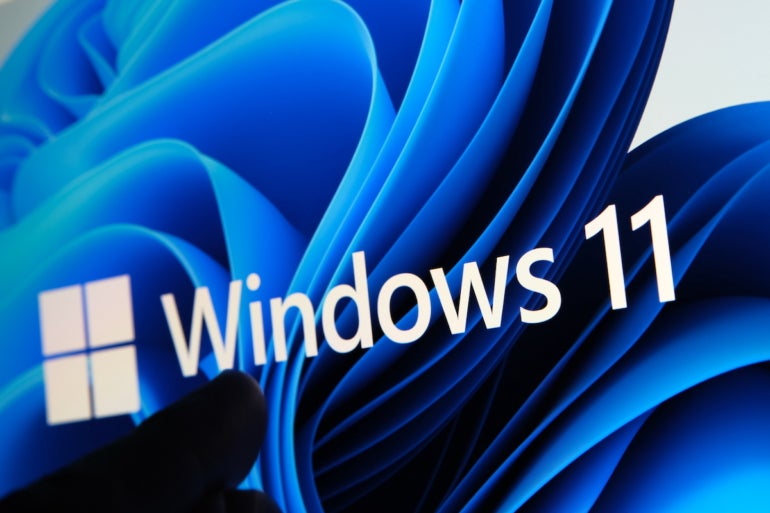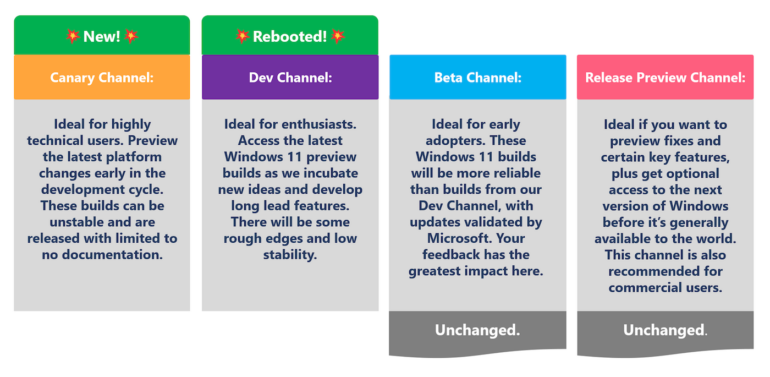
If you want to try possible future Windows features and interface changes and give Microsoft your feedback, as well as help the company ship faster by testing across a wide range of hardware, the Windows Insider program’s new Canary Channel lets you choose how early a look you want to get at those features, based on how comfortable you are with builds that might not be stable. The Canary Channel replaces the old Dev Channel.
Last year, Microsoft made the Dev Channel more experimental, showing different versions of possible future features and user interface approaches to groups of Insider users, with less documentation. Now those long-term experiments will be available through the new Canary Channel, and anyone who was in the Dev Channel before will be automatically moved to Canary.
That includes Windows Insider for Business devices that have been getting 25000 series builds from the old Dev Channel through Windows Update for Business, Intune or Group Policy. If you have a device that wasn’t enrolled in the Windows Insider program and you want to put that in the Canary Channel, you can do that individually for unmanaged devices: The policy for adding commercial devices to Canary Channel will be available “soon” (Microsoft couldn’t give us a date for that).
Jump to:
Canary Channel builds may crash
For now, the Canary Channel looks very much like what Windows Insiders have been getting from the Dev Channel. You’re still getting builds from the 25000 series with features that will take a long time to get built; the builds might involve major changes to Windows at the kernel and API level; the builds probably won’t look the same if they do ship; and the builds might not turn up in a future version of Windows.
What you won’t get is as many blog posts or documentation as when those builds went to the Dev Channel. To get the canary builds to external users almost as fast as they have been going to Windows users inside Microsoft in the past, they will have what Microsoft calls “very little validation and documentation.” There will only be blog posts for flights that add new features, and it’s not clear if known issues and bug fixes will be covered in the release notes. Builds might not be stable, and you might find your PC is unusable until the next build, or even have to reinstall Windows. That’s been rare for the internal canary users at Microsoft, but it has happened.
If you’ve used canary builds for a web browser like Microsoft Edge or Google Chrome, you’re used to getting a new build every day (Firefox calls them Nightly releases). Internal canary builds of Windows have usually been available every couple of days, and sometimes more than once a day if there was an urgent bug that had to be fixed or rolled back. Microsoft says it isn’t planning on daily builds for the Windows Canary Channel, but the builds may come more frequently than Dev Channel builds have.
If Canary Channel builds do get more frequent as well as more experimental and less documented, you should look into the policy you have set for Windows Insider options in your organization. These builds are for highly technical users rather than enthusiasts or early adopters, and you may want to restrict where they can be used, while having the IT organization try them out to keep up with the direction of Windows.
Dev Channel is mainstream
There’s also a new Dev Channel that will have previews of possible new features and experiences for future versions of Windows that may change or not ship, but the 2300 series builds in this channel will be more stable, and Microsoft says they are suitable for most Insiders.
It makes a lot of sense to separate the chance to see future features more quickly and give feedback from the risk of testing out the very earliest builds on a wider range of hardware than Microsoft has access to internally – something that’s an important part of the Insiders program because it exposes bugs and hardware incompatibilities earlier but can also be inconvenient if it means crashes or features that don’t work on your device.
Beta and Release Preview Channels
That leaves the Beta Channel (22000 series builds) for testing what’s most likely to ship with more reliable builds that have already been validated on a wider range of devices, and the Release Preview Channel as a way to try out fixes and key features that have already been decided on and will be shipping in a future update to Windows 10 or Windows 11. Microsoft says the Beta Channel is where Insider feedback will have the greatest impact, so IT teams may want to prioritize trying these builds out in case there are issues they want to bring up while using the Release Preview Channel for a portion of Windows users to get useful new features more quickly (Figure A).
Figure A

Enthusiasts may enjoy hunting through Insider builds for features that are turned off for a hint about what the future holds (that might happen if a feature isn’t finished or if Microsoft doesn’t want to test it widely). Features that are enabled in a build for one channel might be disabled in the build for another channel. The Windows team won’t try to stop people from digging into the builds, but don’t expect to hear anything official about features Microsoft isn’t ready to test.
Changing Windows Insider channels
These new channel options might make you want to change which Windows Insider builds you get.
If you’re in the Beta or Release Preview Channel, you can switch your device into Dev or Canary Channel by changing your Insider settings in Windows Settings.
If you’ve been in the old Dev Channel and prefer the idea of more stable builds while still seeing Microsoft’s new ideas for Windows fairly quickly, you can’t opt out of being moved to the Canary Channel. Instead, you have to perform a clean installation of Windows (Insiders who have problems using the Windows 11 media creation tool to do this will be able to order a clean installation kit from Microsoft) and then pick your Windows Insider channel again.
That’s because you can go from a lower build number of Windows to a higher build number, but you can’t go back from a higher build number to a lower one.
Similarly, once you’re in the Dev Channel, it’s harder to switch to anything except the Canary Channel, which will always have higher build numbers. Microsoft said there may be times when the Beta or Release Preview Channel will have builds with the same number as what’s in the Dev Channel, at which point you can change channels. Use the list of build numbers on the Windows Insider Flight Hub to keep an eye out.
Because the Beta Channel isn’t tied to specific Windows releases, you get an advanced look at features that might come in six months or 16 months. But that also means there isn’t an easy way to opt out of staying on Windows Insider builds the way you can with the Release Preview Channel every time a new Windows version ships. You can only choose Stop Getting Preview Builds under Settings | Windows Update | Windows Insider Program when the build you’re running is available as a stable, shipping version of Windows.
Microsoft now provides occasional off-ramps for the Beta Channel: If you want to unenroll your device, you need to do that very quickly because the current window only runs until March 8, 2023 (the day after Patch Tuesday delivers new features that have been in the Beta Channel). If you miss this window, there will be another off-ramp probably in the fall when the next annual release of Windows happens.
If a future off-ramp lines up with the right build numbers, you might be able to go from the Dev Channel to the Beta Channel and then turn off Windows Insider builds. But if you want to move from the new Canary Channel to any other Windows Insider channel or current release Windows, you will have to uninstall Windows, so make sure you’ll be comfortable doing that before you sign up.
Read next: Microsoft PowerToys 0.68.0: A breakdown of two new applications (TechRepublic)
Source of Article



